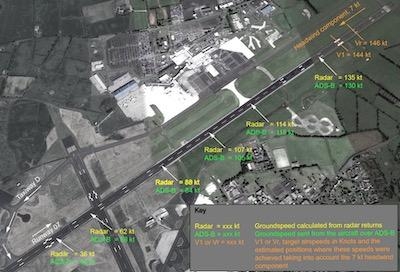Tue, Nov 27, 2018
Temperature Data Incorrectly Entered Into Flight Computer
The U.K. Air Accident Investigation Branch (AAIB) has issued a report from an incident which occurred in July of last year involving a Sunwings Boeing 737-800 departing Belfast for Corfu, Greece.

According to the report, at 1539 hrs on July 21 2017, the Boeing 737-800 took off from Belfast International Airport (BFS) with insufficient power to meet regulated performance requirements. The aircraft struck a supplementary runway approach light, which was 14 inches tall and 95 feet beyond the end of the takeoff runway.
An outside air temperature (OAT) of -52°C (-61°F) had been entered into the Flight Management Computer (FMC) instead of the actual OAT of 16°C (60°F). This, together with the correctly calculated assumed temperature thrust reduction of 48°C (118°F), meant the aircraft engines were delivering only 60% of their maximum rated thrust. The low acceleration of the aircraft was not recognised by the crew until the aircraft was rapidly approaching the end of the runway. The aircraft rotated at the extreme end of the runway and climbed away at a very low rate. The crew did not apply full thrust until the aircraft was approximately 4 km from the end of the runway, at around 800 ft aal.
There was no damage to the aircraft, which continued its flight to Corfu, Greece without further incident. However, it was only the benign nature of the runway clearway and terrain elevation beyond, and the lack of obstacles in the climb-out path which allowed the aircraft to climb away without further collision after it struck the runway light. Had an engine failed at a critical moment during the takeoff, the consequences could have been catastrophic.
The investigation found the following causal factors for this serious incident:
- An incorrect OAT was entered into the FMC, which caused the FMC to calculate an N1 setting for takeoff which was significantly below that required for the aircraft weight and environmental conditions.
- The incorrect OAT was not identified subsequently by the operating crew.
- The abnormal acceleration during the takeoff run was not identified until the aircraft was rapidly approaching the end of the runway, and no action was taken to either reject the takeoff or increase engine thrust.
The investigation found the following contributory factors for this serious incident:
- The aircraft’s FMC did not have the capability to alert the flight crew to the fact that they had entered the incorrect OAT into the FMC, although this capability existed in a later FMC software standard available at the time.
- The Electronic Flight Bags (EFB) did not display N1 on their performance application (some applications do), which meant that the crew could not verify the FMC-calculated N1 against an independently-calculated value.
- The crew were unlikely to detect the abnormally low acceleration because of normal limitations in human performance.
The investigation identified other examples of accidents or serious incidents where there was a gross failure of an aircraft to achieve its expected takeoff performance, and found that technical solutions to address this serious safety issue are now feasible.
(Image from AAIB report)
More News
Omnidirectional Approach Lighting System ODALS consists of seven omnidirectional flashing lights located in the approach area of a nonprecision runway. Five lights are located on t>[...]
"Polaris Dawn, the first of the program’s three human spaceflight missions, is targeted to launch to orbit no earlier than summer 2024. During the five-day mission, the crew >[...]
Also: 1800th E-Jet, Uncle Sam Sues For Landing Gear, Embraer Ag Plane, Textron Parts A friend of the family reported that Lt. Col. (Ret.) Richard Glenn Rutan flew west on Friday, M>[...]
Also: Virgin Galactic, B-29 Doc to Allentown, Erickson Fire-Fighters Bought, FAA Reauthorization After dealing with a big letdown after the unexpected decision by Skyreach to disco>[...]
“Our aircrews are trained and capable of rapidly shifting from operational missions to humanitarian roles. We planned to demonstrate how we, and our BORSTAR partners, respond>[...]
 ANN's Daily Aero-Term (05.05.24): Omnidirectional Approach Lighting System
ANN's Daily Aero-Term (05.05.24): Omnidirectional Approach Lighting System Aero-News: Quote of the Day (05.05.24)
Aero-News: Quote of the Day (05.05.24) Airborne 05.06.24: Gone West-Dick Rutan, ICON BK Update, SpaceX EVA Suit
Airborne 05.06.24: Gone West-Dick Rutan, ICON BK Update, SpaceX EVA Suit Airborne 05.03.24: Advanced Powerplant Solutions, PRA Runway Woes, Drone Racing
Airborne 05.03.24: Advanced Powerplant Solutions, PRA Runway Woes, Drone Racing Aero-News: Quote of the Day (05.06xx.24)
Aero-News: Quote of the Day (05.06xx.24)



